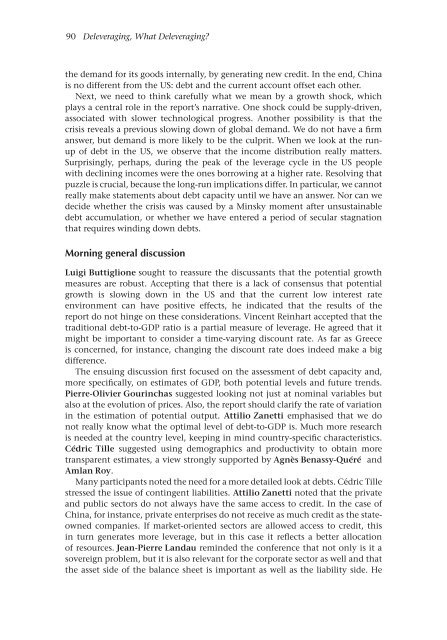1qGLG9p
1qGLG9p
1qGLG9p
You also want an ePaper? Increase the reach of your titles
YUMPU automatically turns print PDFs into web optimized ePapers that Google loves.
90 Deleveraging, What Deleveraging<br />
the demand for its goods internally, by generating new credit. In the end, China<br />
is no different from the US: debt and the current account offset each other.<br />
Next, we need to think carefully what we mean by a growth shock, which<br />
plays a central role in the report’s narrative. One shock could be supply-driven,<br />
associated with slower technological progress. Another possibility is that the<br />
crisis reveals a previous slowing down of global demand. We do not have a firm<br />
answer, but demand is more likely to be the culprit. When we look at the runup<br />
of debt in the US, we observe that the income distribution really matters.<br />
Surprisingly, perhaps, during the peak of the leverage cycle in the US people<br />
with declining incomes were the ones borrowing at a higher rate. Resolving that<br />
puzzle is crucial, because the long-run implications differ. In particular, we cannot<br />
really make statements about debt capacity until we have an answer. Nor can we<br />
decide whether the crisis was caused by a Minsky moment after unsustainable<br />
debt accumulation, or whether we have entered a period of secular stagnation<br />
that requires winding down debts.<br />
Morning general discussion<br />
Luigi Buttiglione sought to reassure the discussants that the potential growth<br />
measures are robust. Accepting that there is a lack of consensus that potential<br />
growth is slowing down in the US and that the current low interest rate<br />
environment can have positive effects, he indicated that the results of the<br />
report do not hinge on these considerations. Vincent Reinhart accepted that the<br />
traditional debt-to-GDP ratio is a partial measure of leverage. He agreed that it<br />
might be important to consider a time-varying discount rate. As far as Greece<br />
is concerned, for instance, changing the discount rate does indeed make a big<br />
difference.<br />
The ensuing discussion first focused on the assessment of debt capacity and,<br />
more specifically, on estimates of GDP, both potential levels and future trends.<br />
Pierre-Olivier Gourinchas suggested looking not just at nominal variables but<br />
also at the evolution of prices. Also, the report should clarify the rate of variation<br />
in the estimation of potential output. Attilio Zanetti emphasised that we do<br />
not really know what the optimal level of debt-to-GDP is. Much more research<br />
is needed at the country level, keeping in mind country-specific characteristics.<br />
Cédric Tille suggested using demographics and productivity to obtain more<br />
transparent estimates, a view strongly supported by Agnès Benassy-Quéré and<br />
Amlan Roy.<br />
Many participants noted the need for a more detailed look at debts. Cédric Tille<br />
stressed the issue of contingent liabilities. Attilio Zanetti noted that the private<br />
and public sectors do not always have the same access to credit. In the case of<br />
China, for instance, private enterprises do not receive as much credit as the stateowned<br />
companies. If market-oriented sectors are allowed access to credit, this<br />
in turn generates more leverage, but in this case it reflects a better allocation<br />
of resources. Jean-Pierre Landau reminded the conference that not only is it a<br />
sovereign problem, but it is also relevant for the corporate sector as well and that<br />
the asset side of the balance sheet is important as well as the liability side. He


